You use a gate valve to start or stop the flow of fluids in a pipe. This device relies on a sliding plate, called a gate, which moves up or down to open or close the passage. When you fully open the gate valve, the flow faces almost no blockage, so pressure drops very little. You will find these valves in many industries because they handle high pressure and create a tight seal. Always use a gate valve for on-off control, not for adjusting flow, since partial opening can harm the valve.
要点
Gate valves work by moving a gate up or down. This opens or closes the path for fluid. They are best for turning flow on or off. They are not good for changing how much fluid flows.
When open all the way, gate valves let fluid pass easily. There is almost no pressure loss. They can handle high pressure and heat. They work with many kinds of fluids.
There are different types of gate valves. These include wedge, parallel, and knife gate. Each type is good for different jobs. Pick one based on pressure, fluid type, and how often you use it.
To use a gate valve right, open and close it slowly. This helps stop damage. Clean and oil the stem often to make it last longer.
Gate valves are used in many industries. These include oil and gas, water treatment, and power plants. Do not use them to control flow amount. This can cause damage.
What Are the Basics of Gate Valve Operation?
Gate valves operate by lifting a gate out of the path of the fluid. They are primarily used to start or stop the flow of liquid in a pipeline, providing a straight-line flow with minimal restriction.
仕組み
You control a gate valve by moving a gate or wedge up and down inside the valve body. When you turn the handwheel or use an actuator, the gate lifts to let fluid pass or lowers to block the flow. This vertical movement sets gate valves apart from other valves, which may use different methods to control flow.
Gate valves use a gate or wedge that moves up and down to open or close the passage.
You can operate them manually with a handwheel or lever, which works well if you do not need to adjust the valve often.
Electric actuators let you open or close the valve remotely with precise control.
Pneumatic actuators use air pressure for quick and reliable movement, which is helpful in places with compressed air.
Hydraulic actuators use hydraulic pressure to move large gates with high force.
Tip: The gate valve’s design makes it ideal for on-off service, not for adjusting flow. You should always use it in either the fully open or fully closed position.
When you want to open a gate valve, you usually turn the handwheel counterclockwise. This action raises the gate and allows fluid to flow freely. To close the valve, you turn the handwheel clockwise, which lowers the gate and stops the flow. Always turn the handwheel slowly and avoid forcing it. This helps prevent damage to the valve’s parts.
Here are the main steps you follow to operate a gate valve:
Turn the handwheel or actuator counterclockwise to raise the gate and open the valve.
Open the valve slowly and steadily to avoid sudden surges or system problems.
To close, turn the handwheel or actuator clockwise to lower the gate.
Close the valve gently to avoid jamming or damaging the gate.
Make sure the valve is fully closed to prevent leaks.
Open vs. Closed
When you fully open a gate valve, you create a straight path for fluid. This design means the fluid faces almost no resistance, so pressure drops very little. The valve allows flow in both directions, and you do not need to worry about which way you install it.
Gate valves provide a straight-through passage with almost zero flow resistance when open.
The flow direction is unrestricted, and the valve works the same in both directions.
You need only a small amount of force to open or close the valve.
The valve requires more space to install because the gate travels a long distance.
When you close the gate valve, the gate presses tightly against the valve seats. This action seals the passage and stops the flow. The pressure from the fluid helps create a tight seal, but the sealing surfaces can wear down over time because they rub against each other during operation.
Gate valves are not good for throttling or adjusting flow. If you leave the valve partially open, the flow becomes turbulent, which can damage the gate and seats.
The valve is best for applications where you need to start or stop flow completely.
以下はその表である。 typical leakage rates for properly closed gate valves according to industry standards:
Valve Size (NPS) | Max Liquid Leakage (drops/min) | Max Liquid Leakage (ml/min) | Max Gas Leakage (bubbles/min) | Max Gas Leakage (ml/min) |
|---|---|---|---|---|
2 | 0 | 0 | 0 | 0 |
4 | 8 | 0.5 | 16 | 0.16 |
6 | 12 | 0.75 | 24 | 0.24 |
8 | 16 | 1 | 32 | 0.32 |
10 | 20 | 1.25 | 40 | 0.4 |
12 | 24 | 1.5 | 48 | 0.48 |
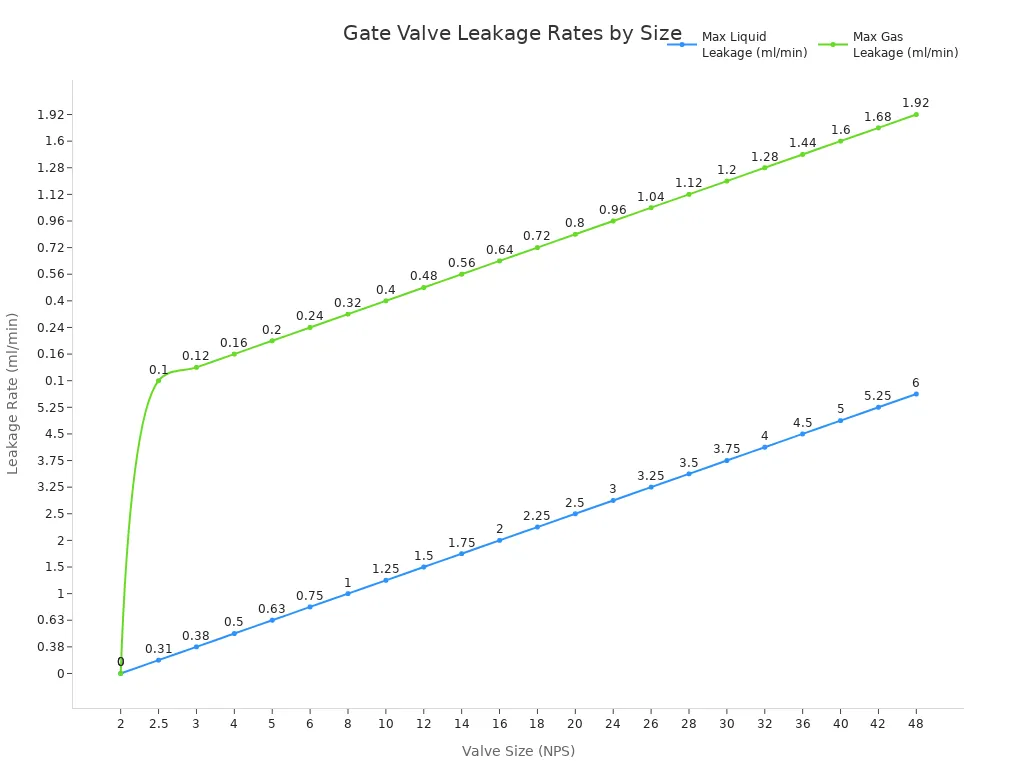
According to the API 598 standard, a properly closed gate valve should not leak any liquid or gas that you can see. This high level of sealing makes the gate valve a reliable choice for stopping flow in many systems.
What Are the Main Components of a Gate Valve?
A gate valve primarily consists of the body, gate, stem, bonnet, and actuator. These components work together to control the flow of fluid through a pipeline by lifting or lowering the gate.
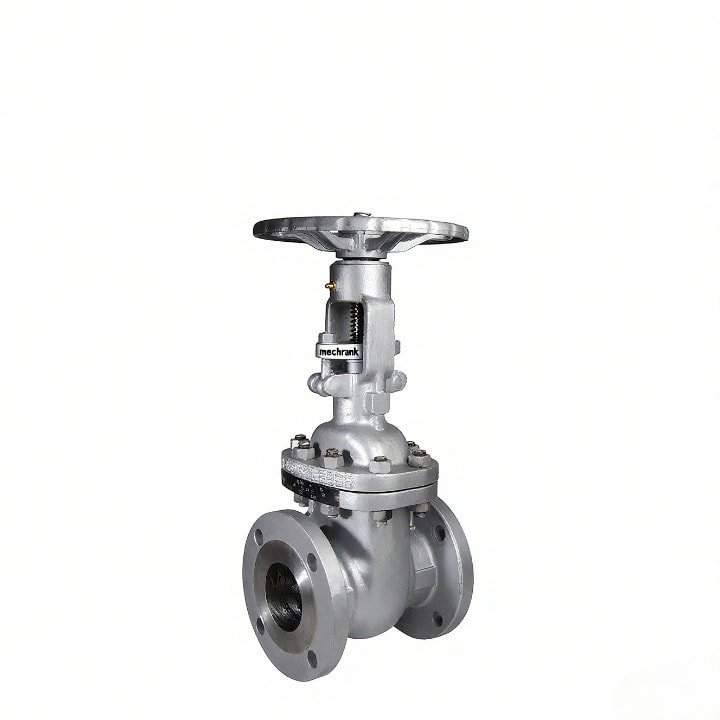
Body and Gate
The body and gate are the main parts of a gate valve. The body holds everything together and connects to the pipe. The gate moves up or down to stop or let fluid flow. The material for these parts depends on what job they do and what fluid is in the pipe. Here is a table that lists common materials and how they are used:
素材 | Features and Properties | 代表的なアプリケーション |
|---|---|---|
Bronze | High lead content, good for steam, air, gas, HVAC, marine | Low-pressure manufacturing, marine environments |
鋳鉄 | Good casting, corrodes over time, low tensile strength | Water, wastewater, HVAC, underground, low-pressure |
Cast Steel | Tough, hard, high tensile strength, impact resistant | High temperature and pressure industrial plants |
Ductile Iron | Used for gates in resilient and metal-seated valves | Water distribution, sealing with bronze rings |
The way the gate is made changes how well it seals. A flexible wedge can bend if the pipe gets hot or stressed. This helps stop leaks. A solid wedge is strong but can get stuck if the valve body bends. Some gates have two pieces, called a split wedge. These help with heat changes but can trap dirt and make sealing worse.
Stem and Actuator
The stem links the handwheel or actuator to the gate. When you turn the handwheel, the stem moves the gate up or down. Different actuators can make this easier or automatic. The main types are pneumatic, hydraulic, and electric actuators. Pneumatic actuators use air pressure to move fast and work well. Hydraulic actuators use fluid pressure for strong and careful movement, which is good for big valves. Electric actuators use motors and gears for clean and exact control. These are common in systems that run by themselves.
Tip: If you keep the stem clean and oiled, it will last longer. With good care, a stem can work for 10 to 30 years.
Seats and Seals
Seats and seals stop leaks when the valve is closed. Metal seats are made from stainless steel, bronze, or nickel alloys. These metals are good for high pressure or heat and do not rust easily. For lower pressure or softer seals, rubber like EPDM or PTFE is used. The material you pick changes how much heat and pressure the valve can take. Look at this chart to see the temperature limits for different seat and seal materials:

Soft seats, like rubber or PTFE, press against the gate for a tight seal. Metal seats are better for tough jobs but may not seal as tightly. The best choice depends on your system, the fluid, the temperature, and the pressure.
What Are the Different Types of Gate Valves?
Parallel and WedgeGate valves come in several types, including rising stem (OS&Y), non-rising stem, wedge, and parallel. Each type has distinct features suited for various applications and environments.
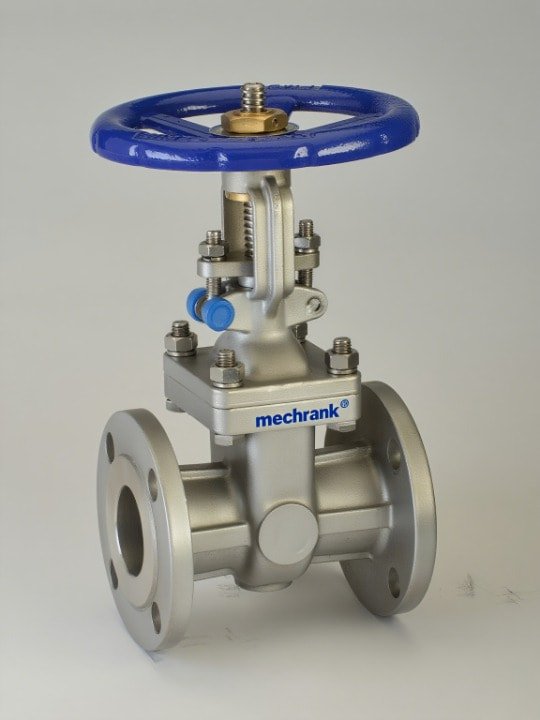
There are two main gate valve designs: parallel and wedge. Each one works best in different jobs. Look at this table to compare them:
アスペクト | Wedge Gate Valve | Parallel Gate Valve |
|---|---|---|
デザイン | The gate is wedge-shaped and presses tight when closed. | The gate is flat and sits between two seats for smooth flow. |
Sealing Performance | Works well with high pressure, heat, and harsh fluids. | Good for low pressure and big pipes, but not as strong at high pressure. |
Operating Torque | Needs more force to open and close. | Easier to use and needs less force. |
Fluid Resistance | Has a bit more resistance because of the wedge shape. | Has less resistance, so fluid moves easier. |
Flow Regulation | Not good for changing flow; best fully open or closed. | Can adjust flow and is good for frequent use. |
代表的な用途 | Used for steam, chemical plants, and power stations. | Used for water supply, city pipes, and systems that open and close a lot. |
Service Life | Can wear out faster from high pressure and heat. | Lasts longer because there is less wear and smoother flow. |
注: Pick a wedge gate valve for high pressure or heat. Use a parallel gate valve for big pipes or if you open and close it often.
Parallel gate valves are good in power plants and water treatment. They do not get stuck when temperatures change fast. Wedge gate valves can stick if it gets hot or cold quickly, but they seal better when things get tough.
Knife Gate Valve
Knife gate valves have a sharp, thin gate that cuts through thick or dirty fluids. These valves are used for slurry, sludge, or fluids with sand and solids. Here are some things that make knife gate valves special:
The sharp gate slices through thick or sticky fluids.
Strong design handles rough and thick materials.
The full opening lets fluid flow with almost no pressure drop.
Soft seats help seal tightly and stop leaks.
Made from strong metals like stainless steel, cast iron, or special alloys for tough jobs.
Comes in different styles: one-way, two-way, wafer (small), and lug-style (easy to remove).
You will see knife gate valves in wastewater plants, mining, paper mills, and chemical factories. Stainless steel is often used because it does not rust and lasts longer. For sealing, PTFE, EPDM, or ceramic seats are used to stop leaks and handle rough fluids.
Tip: Knife gate valves are simple to fix and do not take up much space. Their easy design means fewer parts to repair or replace.
Stem Types
The stem links the handwheel or actuator to the gate. There are two main types: rising stem and non-rising stem. This table shows how they are different:
特徴 | Rising Stem Gate Valve | Non-Rising Stem Gate Valve |
|---|---|---|
Stem Movement | The stem stays inside and only turns. | |
Space Needed | Needs more room above the valve. | Fits in small or underground spaces. |
Position Indicator | Easy to see if it is open or closed. | You must look at the handle to check. |
メンテナンス | Easy to oil and check. | Harder to care for, threads are inside. |
ベストユース | Good if you need to see the valve’s position. | Good for tight or underground spots. |
Pick a rising stem if you want to see if the valve is open or closed. Non-rising stems are better for small or underground places. Remember, rising stems need oil because the threads are outside. Non-rising stems keep threads safe but are harder to check and oil.
What Are the Applications and Advantages of Gate Valves?
Gate valves are primarily used in applications requiring a straight-line flow of fluid with minimal restrictions. They are commonly found in water supply systems, oil and gas pipelines, and various industrial processes.
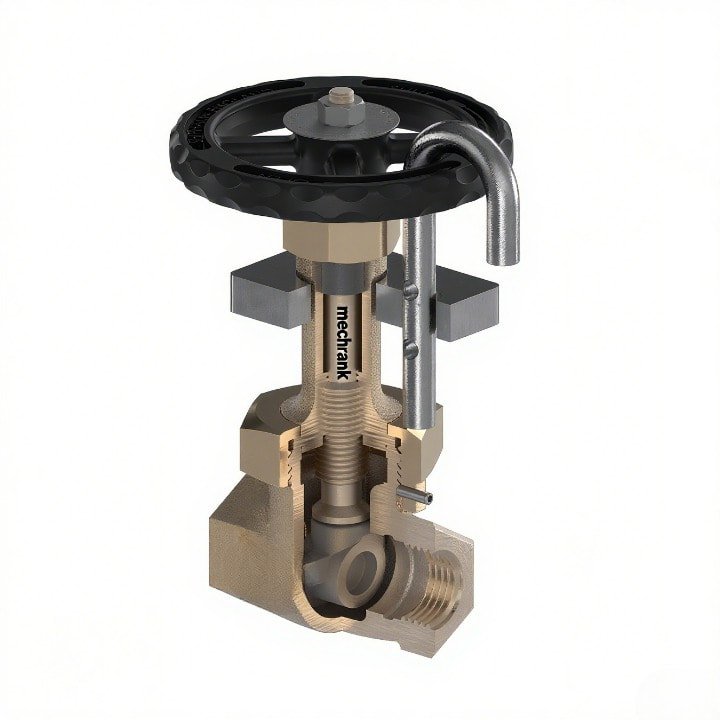
一般的な用途
You see these valves in many different industries. They are good for starting or stopping flow in pipes. In oil and gas, people use them to shut off pipelines and control flow. Water treatment plants use them to move water in city and factory systems. Power plants use them to control steam and close off parts for repairs. Mining companies use them for thick slurries and fluids with solids. The table below shows where these valves are used:
産業 | 一般的なアプリケーション |
|---|---|
Oil and Gas | Pipeline isolation, process flow control |
Petrochemical | Handling aggressive chemicals, high-pressure systems |
水処理 | Regulating water flow in municipal setups |
発電 | Managing steam flow, isolation in power plants |
鉱業 | Handling abrasive slurries, fluids with solids |
メリット
When the valve is fully open, fluid moves in a straight line. The opening is as wide as the pipe, so fluid flows easily. There is almost no pressure drop, which keeps the system working well. The valve is strong and can handle high pressure and heat. You can use it with many fluids, even those with solids or chemicals. Here are some main benefits:
There is little pressure loss because the path is wide and clear.
The valve works in places with high pressure and heat.
It can be used for water, oil, steam, and slurries.
Cleaning tools can move through the pipe without trouble.
The valve lasts a long time because it is simple and strong.
注: The full bore design helps stop turbulence and cavitation. This makes your system safer and more efficient.
制限事項
This valve is not good for adjusting flow. If you leave it partly open, the fluid can shake and wear out the gate and seats. This can cause leaks and damage over time. The valve is best for turning flow on or off, not for small changes. Here are some main limits:
The valve does not control flow well and is not for throttling.
Fast flow near the seat when partly open can wear it out.
Vibration can hurt the inside parts and make the valve last less.
Fixing worn seats or gates is hard and can cost a lot.
Opening the valve partway often can cause leaks and make it fail.
ヒント If you need to control flow exactly, use a globe or needle valve instead.
How Does a Gate Valve Operate and How Do You Select the Right One?
A gate valve operates by lifting a gate out of the path of the fluid. It is used to start or stop the flow and is not suitable for regulating flow. When selecting a gate valve, consider factors such as the type of fluid, pressure, temperature, and material compatibility.
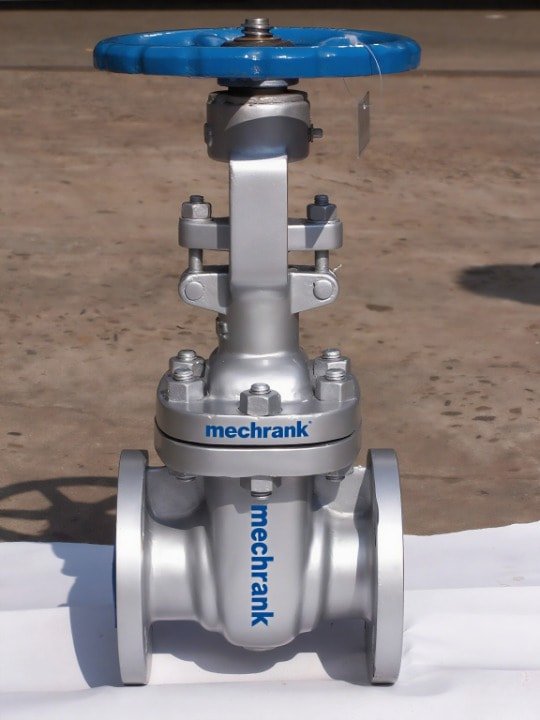
Identifying Valve Position
You need to know if a valve is open or closed before you start work. Several standard methods help you check the position safely and quickly:
Look at the stem: For rising stem valves, the stem sticks out when open. If you see the stem fully raised, the valve is open. For non-rising stem valves, count the number of turns on the handwheel. Usually, four to six full turns counterclockwise mean the valve is open.
Check the handwheel direction: When the handle lines up with the pipe, the valve is open. If the handle sits across the pipe, the valve is closed.
Measure the stem height: Some valves have marks or rulers. According to API 600, the stem should rise at least 1.2 times the valve diameter when open.
Read gauges: If the flow rate matches what you expect and the pressure drop is low, the valve is open. If the pressure is high on one side and low on the other, the valve is closed.
Listen for flow: A smooth, steady sound means the valve is open. Silence near the valve means it is closed.
ヒント Position indicators make your job easier. They show if the valve is open, closed, or stuck. You can see this from a control room or right at the valve. Some indicators even send alarms if the valve does not move as it should. This helps you spot problems early and keep your system safe.
When to Use a Gate Valve
You should choose this valve when you need to start or stop flow completely. It works best in these situations:
You want a full, clear path for fluid with almost no pressure loss.
You need to handle high pressure or high temperature.
You use the valve only a few times each day, not for constant adjusting.
You want to move water, oil, steam, or thick slurries.
You need a valve that lasts a long time and is easy to maintain.
When you select a valve, think about these factors:
Pick materials that resist corrosion and handle your fluid’s temperature.
Choose the right stem type for your space and maintenance needs.
Check that the end connections fit your piping.
Look for valves that meet industry standards for safety and quality.
Decide if you need manual or automatic operation.
Balance cost with how long the valve will last and how easy it is to fix.
注: Do not use this valve for flow control or throttling. If you need to adjust flow often, pick a globe or ball valve instead.
You can rely on gate valves to start or stop flow in many systems. When you choose a valve, check the force needed to operate it and look for clear labels. Pick valves that are easy to maintain and clean. Use coatings to protect against rust and buildup. For dirty fluids, knife gate valves work best. Always match the valve size and material to your system’s needs. If you need to adjust flow often, consider other valve types.
よくあるご質問
What is the main purpose of a gate valve?
You use a gate valve to start or stop the flow of liquid in a pipe. It works best when you need a full, clear path for the fluid. You should not use it to control flow speed.
Can you use a gate valve for throttling?
No, you should not use a gate valve for throttling. If you leave it partly open, the flow can damage the gate and seats. Always use it fully open or fully closed.
How do you know if a gate valve is open or closed?
You can check the stem position. If the stem sticks out, the valve is open. If the stem is down, the valve is closed. Some valves have marks or indicators to help you see the position.
What fluids can pass through a gate valve?
Water
Oil
Steam
Slurries with solids
You can use gate valves with many fluids. Always check the valve material to make sure it matches your fluid type.

